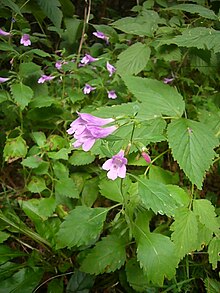Clinopodium grandiflorum
Appearance
This article needs additional citations for verification. (April 2023) |
| Large-flowered calamint | |
|---|---|

| |
| Scientific classification | |
| Kingdom: | Plantae |
| Clade: | Tracheophytes |
| Clade: | Angiosperms |
| Clade: | Eudicots |
| Clade: | Asterids |
| Order: | Lamiales |
| Family: | Lamiaceae |
| Genus: | Clinopodium |
| Species: | C. grandiflorum
|
| Binomial name | |
| Clinopodium grandiflorum (L.) Kuntze
| |
| Synonyms[1] | |
Clinopodium grandiflorum, the large-flowered calamint, showy calamint or mint savory, is a species of ornamental plant.
Description
C. grandiflorum is a perennial herb that grows up to 25 cm (9.8 in) tall. It has pink flowers and ovate green leaves.[2]
Distribution and habitat
It grows in certain mountains of western and southern Europe (Massif Central, Alps, Pyrénées,...) above 700 meters high. It can be found in beech forests.
Use
It can be used in cooking, and in herbal medicine for bruises and cramps.[3][unreliable source?]. In the Aubrac region of France, it is used as an infusion and called "thé d'Aubrac" (Aubrac tea); it is appreciated for its digestive properties.
References
- ^ "Clinopodium grandiflorum (L.) Kuntze". Plants of the World Online. Royal Botanic Gardens, Kew. 2023. Retrieved 7 March 2023.
- ^ "Clinopodium grandiflorum | greater calamint Herbaceous Perennial/RHS Gardening". www.rhs.org.uk. Retrieved 2023-04-11.
- ^ "Medicinal uses". Herbs. Retrieved 6 January 2012.
- Pink, A. (2004). Gardening for the Million. Project Gutenberg Literary Archive Foundation.
External links
This article needs additional or more specific categories. (March 2023) |
